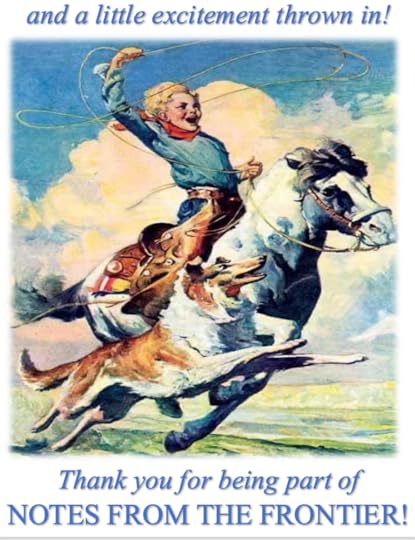Deborah Hufford's Blog: https://www.NotesfromtheFrontier.com
November 21, 2025
The Oldest Canoes Ever Unearthed in the Americas Found in Wisconsin Lake
November 9, 2025
What the Heck is a Buffalo Wallow?
May 24, 2025
Honoring The Native American Military Tradition This Memorial Day Weekend
May 2, 2025
A Great Native American, A Great Leader, A Great Man
April 12, 2025
The Dire Wolf Rises Again!
March 26, 2025
My English Setter Rescue, Loki (from Turkey!) & His First Week in Wisconsin
February 4, 2025
Baby Horses' "Fairy Slippers"
One of the amazing little miracles of Nature: Gestating foals grow protective coverings on the little feet to protect their mothers from their kicking in the womb
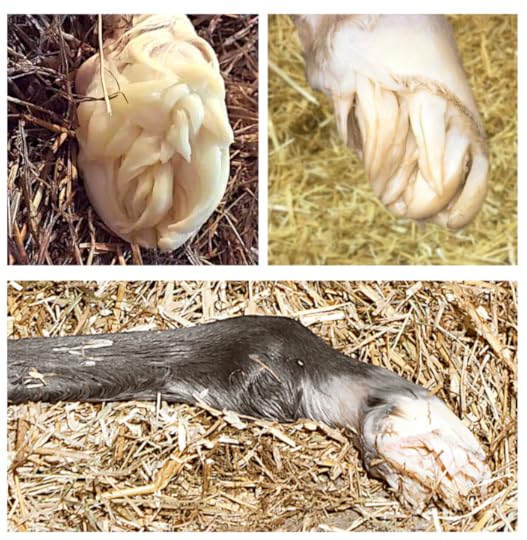
Baby horses in utero develop "fairy slippers" over their hooves to protect the mother's uterus and birth canal. The "slippers" are called eponychium, composed of skin cells in the form of feathered layers to cover the hooves. They have a firm but squishy texture similar to boiled cabbage. They will fall off after the foal stands up and walks.
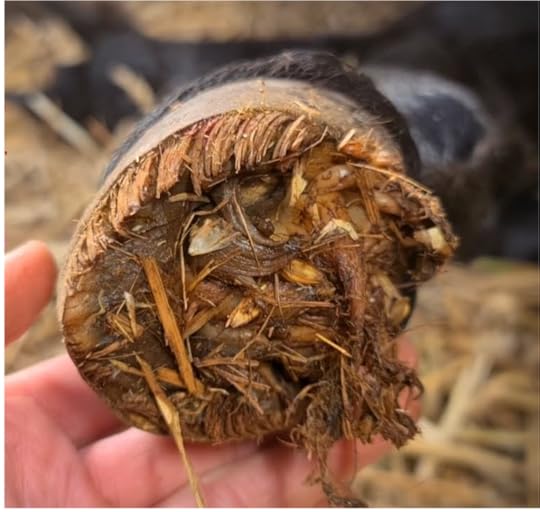
This above image shows a foal's fairy slipper after the foal has stood up and walked around. The feathers dry and crumble off as the foal gets more active.
As horses grow and mature, their baby fairy slippers transform into fleet-footed, flying hooves of steel, full of lightning, magical and tranporting.
You may enjoy these related posts:
-The History of Appaloosas
https://www.notesfromthefrontier.com/post/the-history-of-appaloosas
• For the Love of Horses (& Mules!)
https://www.notesfromthefrontier.com/post/for-the-love-of-horses-mules
-In Honor of a Magnificent War Horse
https://www.notesfromthefrontier.com/post/in-honor-of-a-magnificent-warhorse
-The Comanche & The Horse
https://www.notesfromthefrontier.com/post/the-comanche-and-the-horse
-Famous Hollywood Horses
https://www.notesfromthefrontier.com/post/horses-of-hollywood-westerns
-Hollywood's Greatest Trick Horse
https://www.notesfromthefrontier.com/post/hollywood-s-greatest-trick-horse
"Baby Horses' Fairy Slippers" was first published on Facebook and NotesfromtheFrontier.com on February 6, 2025
© 2025 NOTES FROM THE FRONTIER
December 31, 2024
December 10, 2024
How Did Indians Survive Brutal Winters?
Those of us who live in the northern half of the United States and in Canada have the luxury of modern heat during our brutal winters. But how did Native Americans survive the killing cold?
The winter months bring blizzards and raging winds and killing temperatures. But we sit in our heated homes and sleep in cozy beds under thick comforters. How did Indians survive the brutal winters, especially on the wind-swept open prairies and in the icy mountains?
Native Americans primarily stayed warm in the winter by wearing thick clothing and footwear made from hides and furs from animals available in their area. They layered them the hide clothing and furs to adapt to the temperature. They also utilized fire inside their dwellings, which were designed to retain heat from a central fire; different tribes adapted their strategies based on their environment and available resources, with some focusing on hunting animals like buffalo for their hides and others using materials like reeds and grass for insulation.
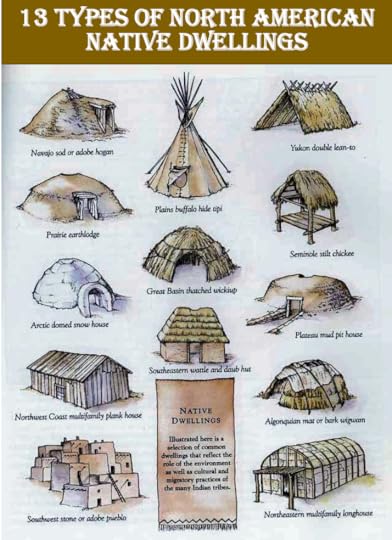
DWELLINGS
North American Indians stayed warm, first of all, by building dwellings made of materials from their natural environment: animals hides, animal furs, grasses, trees, barks, soil, clay, rocks, and ice. Often dwellings, like the longhouse, provided housing for many families, whose combined body heat helped to provide natural heat in a shelter.
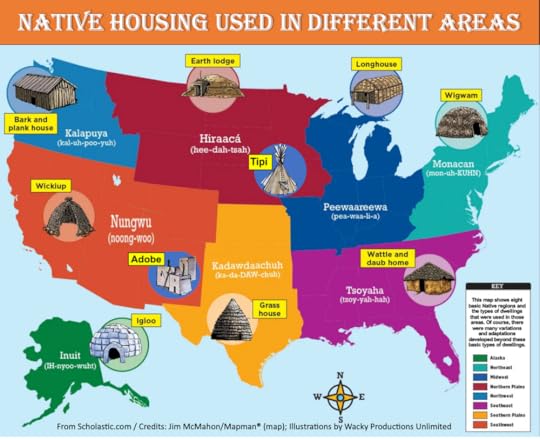
TIPIS
Americans are most familiar with the iconic tipi, that was used widely by the Plains Indians. Tipis were made of long poles and animals hides, often of buffalo because the hide was very large and tough. The tipis could also be quite large and accommodate an entire family.
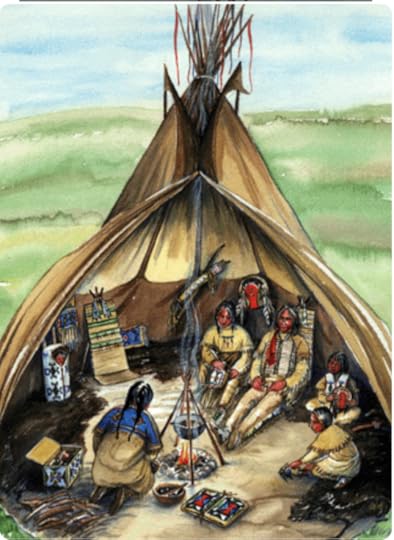
A tipi interior typically featured a small, centrally located fire pit in the middle of the tipi for central heat and cooking. The fire was directly under the smoke flap at the top of the tipi. The conical formation of the tipi, with the smoke hole at the top allow the smoke to rise and escape through the opening while providing warmth and light within the space with careful attention to ventilation to manage smoke buildup.
SEE LINK BELOW, "How to Build a Tipi," about how these amazing shelters were constructed and BOUT HOW NATIVE AMERICANS BUILT TIPIS.
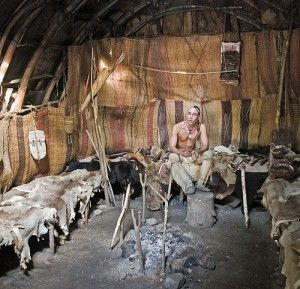
Beds inside tipis were made of buffalo hides (among the Plains Indians) or other hides and blankets layered on top of piles of grass and hay—very light weight and easily packed up for traveling.
Native Americans often kept warm in the winter by heating rocks in a fire and then placing them inside their dwellings, particularly in their tipi shelters, to radiate heat throughout the space. Sometimes water was poured on the rocks to create steam, which also moisture in the air to protect against dry skin. Of course, this system was also used in sweat lodges. (SEE A FUTURE POST ABOUT SWEAT LODGES & THEIR PRACTICAL AND SPIRITUAL PURPOSES).
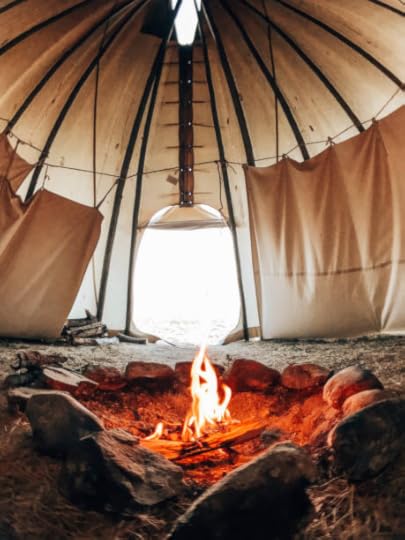
The Plains Indians often used dried buffalo dung, called "chips," to burn in their fires, as it was a readily available fuel source and trees were often scarce on the prairie.
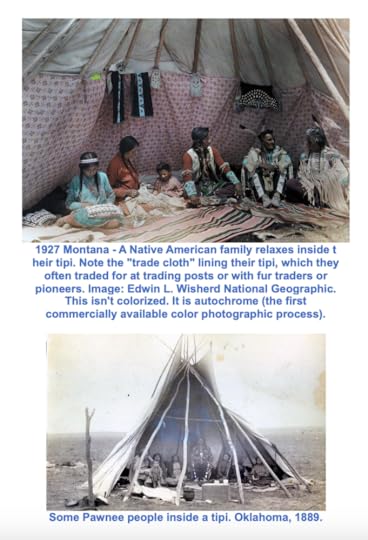
ANIMAL HIDES & FURS
All Native tribes used animal hides and furs as clothing, footwear, blankets, coverings and insulation. Some of the warmest animal hides include:
Eskimos often used caribou for clothing and for their bedding. The hollow hairs of caribou trap air, which provides insulation and makes caribou skin clothing lightweight, durable, and water repellent.
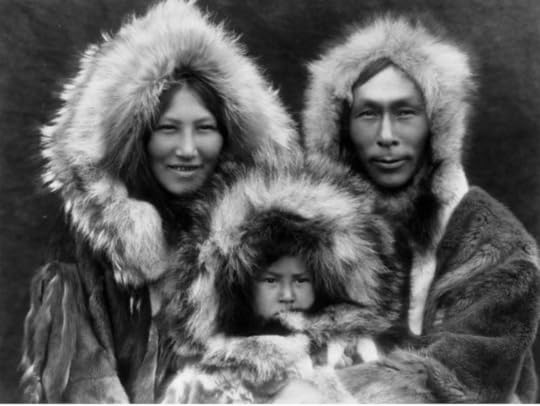
They also used sea otter and sealskins are also considered one of the warmest animals furs on the planet and are also waterproof. Arctic fox was used and the white fur was valued. Bison fur is warmer and more durable than sheep's wool. Bull bison have thicker leather and longer, heavier fur, making them warmer.
Beaver fur is soft, velvety, and luxurious and also waterproof.
Wolf and coyote fur is long and dense and is considered prime winter fur.
Wolverine fur was sometimes worn around the neck and face because the fur is particularly good for shedding frost from a wearer's breath.
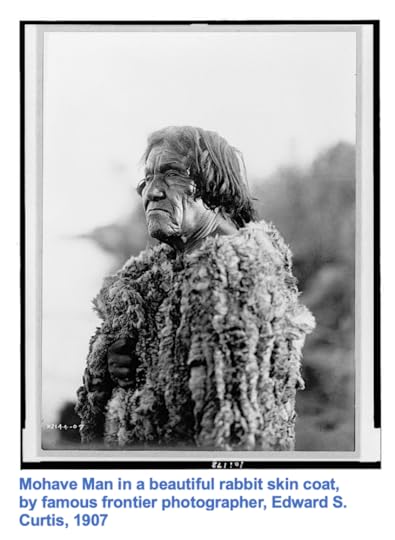
Related Posts You May Enjoy:
• How to Build A Tipi
https://www.notesfromthefrontier.com/post/how-to-build-a-tipi
• How to Build A Cabin
https://www.notesfromthefrontier.com/post/how-to-build-a-cabin
"How Did Indians Survive Brutal Winters?" was first posted on Facebook and Notes from the Frontier on December 6, 2024.
©2024 NOTES FROM THE FRONTIER
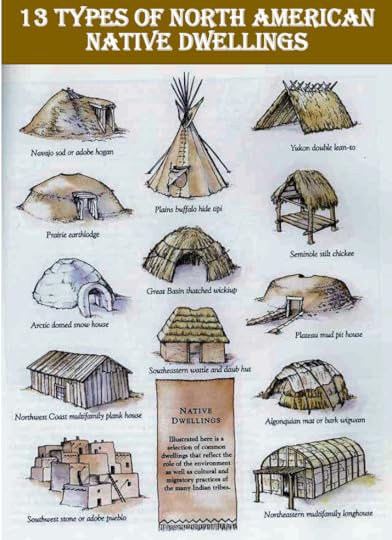
November 26, 2024
Wishing You All A Happy Thanksgiving!!
This famous image by the great Norman Rockwell is the most iconic image Americans associate with Thanksgiving. But the 1943 illustration was not about Thanksgiving, but something even greater.
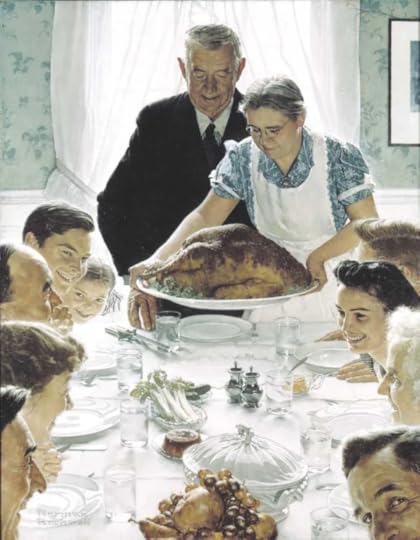
The great Normam Rockwell created 323 illustrated covers for America's most popular magazine, The Saturday EVening Post, for five decades, capturing the best of America. And the image above is one of his most famous. But it was never on the cover of the Saturday Evening Post, nor was it specifically about Thanksgiving!
Rockwell painted this image and three others in response to President Franklin D. Roosevelt's 1941 State of the Union address, which became known as the "Four Freedoms speech." Those freedoms, Roosevelt stated were The Freedom from Want, The Freedom of Speech, The Freedom of Worship, and The Freedom from Fear.
In 1941, when Franklin gave delivered the address, Europe was already embroiled in the beginning of World War II, fighting against the fascists, Hitler and Mussolini, who had already deprived their people of those freedoms and threatened to do so for the rest of the world.
Rockwell produced these four illustrations depicting these freedoms: (beginning upper left, Freedom from Want, Freedom of Speech, Freedom from Fear, and Freedom of Worship.
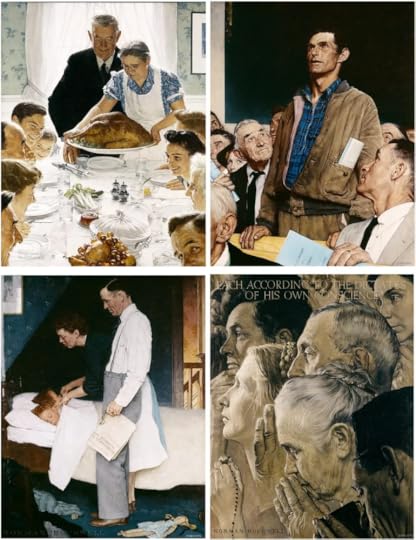
Although Rockwell had originally approached the military for a commission to do the series of posters, "Ours...to fight for," the military didn't like them. But the editor of The Saturday Evening Post, Ben Hibbs, did! They featured the artworks in the March 6, 1943 issue. By then the United States was deeply embroiled in the war itself. The images became so wildly popular, Hibbs printed posters that showed up i schools, post offices and libraries across the country.
The military changed its tune about Rockwell's Ours...To Fight For posters. They asked to use them for their war bonds campaigns that ultimately brought in $132 million in bonds and stamps (worth $.75 billion today)
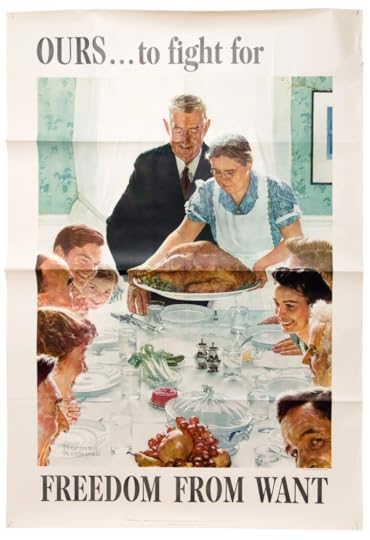
In today's world, ravaged by wars and starvation and our own civil strife, Rockwell's poignant image still means as much now as it did then. It is the iconic image of thanksgiving, family and joy. May we all experience joy and togetherness of family and thankfulness this holiday. Wishing you all peace and good food this Thanksgiving.
If you enjoyed this post, you may enjoy these related posts:
https://www.notesfromthefrontier.com/post/the-first-thanksgivings
https://www.notesfromthefrontier.com/post/the-truth-about-thanksgiving
©2024 Notes from the Frontier
https://www.NotesfromtheFrontier.com
- Deborah Hufford's profile
- 42 followers



